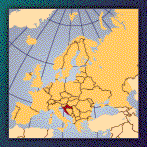| Country (long form) |
Republic of Croatia |
| Capital |
Zagreb |
| Total Area |
21,829.44 sq mi
56,542.00 sq km
(slightly smaller than West Virginia) |
| Population |
4,334,142 (July 2001 est.) |
| Estimated Population in 2050 |
4,388,085 |
| Languages |
Croatian 96%, other 4% (including Italian, Hungarian, Czech, Slovak, and German) |
| Literacy |
97.0% total, 99.0% male, 95% female (1991 est.) |
| Religions |
Roman Catholic 76.5%, Orthodox 11.1%, Muslim 1.2%, Protestant 0.4%, others and unknown 10.8% (1991) |
| Life Expectancy |
70.28 male, 77.73 female (2001 est.) |
| Government Type |
presidential/parliamentary democracy |
| Currency |
1 Croatian kuna (HRK) = 100 lipas |
| GDP (per capita) |
$5,800 (2000 est.) |
| Industry |
chemicals and plastics, machine tools, fabricated metal, electronics, pig iron and rolled steel products, aluminum, paper, wood products, construction materials, textiles, shipbuilding, petroleum and petroleum refining, food and beverages; tourism |
| Agriculture |
wheat, corn, sugar beets, sunflower seed, alfalfa, clover, olives, citrus, grapes, soy beans, potatoes; livestock, dairy products |
| Arable Land |
21% |
| Natural Resources |
oil, some coal, bauxite, low-grade iron ore, calcium, natural asphalt, silica, mica, clays, salt, hydropower |
|


|